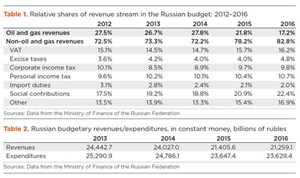Oil & Gas in the Capitals
As oil prices stabilize around $65/bbl (for Brent crude), it’s important to look back at their effect on the Russian economy. As I have said before, the main impact of oil prices is on the budget and the financial sphere. It is obvious, by looking at data compiled from the Ministry of Finance, that revenues for the oil and gas sector have diminished considerably since 2012. This has had significant consequences for the Russian budget.
Share of revenue. The oil price drop was significant from second-half 2014 until early 2016 This led to a reduction in oil’s share of budget revenues, from a high of 27.8% to a low of 17.2%, Table 1. This significant drop implies that a sizeable tax burden was shifted onto the shoulders of households and non-oil & gas producing enterprises.
This drop is even more significant, if we see that budget revenues, in constant 2013 currency, decreased 13% from 2014 until 2016. Actually, oil and gas revenues dropped, in constant money, from 6,721.4 billion to 3,656.5 billion rubles.
This revenue drop was not emulated at the same rate by a drop in budget expenditures, Table 2. They decreased 7% and, consequently, the budget deficit went up, covered partly by diverse reserve funds.
The situation improved in 2017, and this resulted directly from higher oil prices. Nevertheless, we still are under the 2013 level significantly. This makes current prospects for oil production of the utmost importance. Russia is, indeed, a very significant part of the OPEC-Non OPEC 2016 deal that bolstered oil prices.
Production prospects. From a purely technical point-of-view, we can estimate the maximum annual growth rate of oil extraction at 2%, which is putting the maximum volume for 2020 at 575 million tons (m.t.), against 2017’s production of 546 m.t. This limited production growth is, itself, a result of some oil fields maturing quickly, and new ones requiring quite a bit of investment. The strategic relevance of this very question is illustrated by the fact that E&P investments continued to grow during 2015 and 2016, while investment in Russia, as a whole, declined.
But under the deal, Russian production is limited to 550 m.t., implying a loss of 25 m.t., or 175 MMbbl. At the current $65 price, that would be a loss of $11.375 billion. This would, however, not be not very significant, as such a loss, converted into rubles (and assuming a ruble-to-dollar exchange rate of 65-to-1) for 2020 would translate into a loss of 739 billion rubles. By then, if Russia is able to stabilize its inflation rate at 2.5% and maintain 1.9% growth (which is debatable), the total oil and gas revenues would be 5,765 billion rubles (at the 17.2% level).
If we assume that 40% of Russia’s global income from oil goes to the budget, the loss implied by the OPEC-non OPEC deal would be roughly equivalent to 5% of the 2020 oil and gas revenues, or 0.9% of the total budget revenues. Even if oil prices were to grow in the next three years to $80/bbl, this would put the loss implied by the agreement cap at 1.1% of total revenue.
But, this loss could be much more significant, if we look at oil use within Russia. During 2017, of the 546 m.t. produced, about 262.6 m.t. were exported. The 283.4 m.t. left went to refineries, and 136 m.t. of that were consumed domestically for various uses. If the Russian economy conservatively grows at 2%/year, a 550-m.t. production cap would stress the ability of Russian oil companies to satisfy foreign consumers. Also, the specific growth of Russia’s chemical sector, which is already exporting much, as well as an increase in agricultural production, could make the exported volume shrink even more.
It is actually a government policy to develop a crude oil transformation in Russia. But, if Russia is to be limited to a production volume of 550 m.t., it is quite possible that the exported volume would shrink from 262.6 m.t. to 241.5 m.t. in 2020. Even without the deal cap, and even if Russia could actually produce 575 m.t. in 2020, this would imply a very limited increase in crude oil exports, with 266.5 m.t., or a net gain of 3.9 m.t.
Of course, two major factors have not been accounted for—first, the rate of world demand and second, improvement in Russia’s energy efficiency could moderate internal consumption growth. This very factor could ease Russia’s oil export potential. ![]()

- Management issues- Dallas Fed: Activity sees modest growth; outlook improves, but cost increases continue (October 2023)
- Industry at a glance (June 2023)
- Industry at a glance (May 2023)
- Management issues- Dallas Fed: Oil and gas expansion stalls amid surging costs and worsening outlooks (May 2023)
- Industry at a glance (March 2023)
- The last barrel (February 2023)



